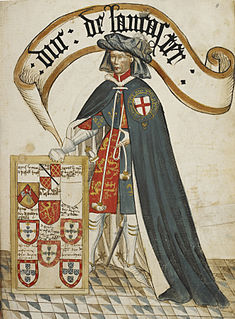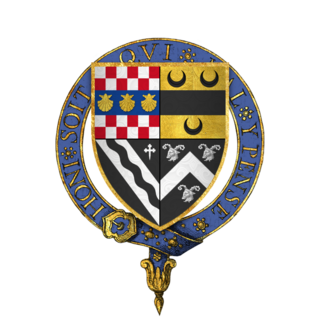
Thomas Beaufort, 1st Duke of Exeter, 1st Earl of Dorset styled 1st Count of Harcourt was an English military commander during the Hundred Years' War, and briefly Chancellor of England. He was the third of the four children born to John of Gaunt, Duke of Lancaster, and his mistress Katherine Swynford. To overcome their problematic parentage, his parents were married in 1396, and he and his siblings were legitimated in 1390 and again in 1397. He married the daughter of Sir Thomas Neville of Hornby, Margaret Neville, who bore him one son, Henry Beaufort. However, the child died young.

The House of Lancaster was a cadet branch of the royal House of Plantagenet. The first house was created when King Henry III of England created the Earldom of Lancaster—from which the house was named—for his second son Edmund Crouchback in 1267. Edmund had already been created Earl of Leicester in 1265 and was granted the lands and privileges of Simon de Montfort, 6th Earl of Leicester, after de Montfort's death and attainder at the end of the Second Barons' War. When Edmund's son Thomas, 2nd Earl of Lancaster, inherited his father-in-law's estates and title of Earl of Lincoln he became at a stroke the most powerful nobleman in England, with lands throughout the kingdom and the ability to raise vast private armies to wield power at national and local levels. This brought him—and Henry, his younger brother—into conflict with their cousin Edward II of England, leading to Thomas's execution. Henry inherited Thomas's titles and he and his son, who was also called Henry, gave loyal service to Edward's son—Edward III of England.

John Beaufort, 1st Duke of Somerset, 3rd Earl of Somerset was an English nobleman and military commander during the Hundred Years War. He was the maternal grandfather of Henry VII.

Henry, 3rd Earl of Leicester and Lancaster was a grandson of King Henry III (1216–1272) of England and was one of the principals behind the deposition of King Edward II (1307–1327), his first cousin.

Henry of Grosmont, 1st Duke of Lancaster, 4th Earl of Leicester and Lancaster, Earl of Derby, also styled as Henry of Lancaster and Lord Lancaster, of Bolingbroke Castle in Lincolnshire, was a member of the English royal family and a prominent English diplomat, politician, and soldier. He was the wealthiest and most powerful peer of the realm. The son and heir of Henry, 3rd Earl of Lancaster, and Maud Chaworth, he became one of King Edward III's most trusted captains in the early phases of the Hundred Years' War and distinguished himself with victory in the Battle of Auberoche. He was a founding member and the second Knight of the Order of the Garter in 1348, and in 1351 was created Duke of Lancaster. An intelligent and reflective man, Grosmont taught himself to write and was the author of the book Livre de seyntz medicines, a highly personal devotional treatise. He is remembered as one of the founders and early patrons of Corpus Christi College, Cambridge, which was established by two guilds of the town in 1352.
Sir Thomas Tresham was a British politician, soldier and administrator. He was the son of Sir William Tresham and his wife Isabel de Vaux, daughter of Sir William Vaux of Harrowden. Thomas's early advancement was due to his father's influence. In 1443 he and his father were appointed as stewards to the Duchy of Lancaster's estates in Northamptonshire, Buckinghamshire, Bedfordshire and Huntingdonshire, and by 1446 Thomas was serving as an esquire for Henry VI, being made an usher of the king's chamber in 1455. He was appointed a Justice of the Peace for Huntingdonshire in 1446, a position he held until 1459, and was returned to Parliament for Buckinghamshire in 1447 and Huntingdonshire in 1449. Despite the Tresham family's close links with the royal court they were also on good terms with Richard Plantagenet, 3rd Duke of York, and when he returned from Ireland in 1450 Tresham and his father went to greet him. Shortly after leaving home on 23 September they were attacked by a group of men involved in a property dispute with his father; William Tresham was killed, and Thomas was injured.
Maud de Chaworth was an English noblewoman and wealthy heiress. She was the only child of Patrick de Chaworth. Sometime before 2 March 1297, she married Henry, 3rd Earl of Lancaster, by whom she had seven children.

The House of Plantagenet was a royal house which originated from the lands of Anjou in France. The name Plantagenet is used by modern historians to identify four distinct royal houses: the Angevins, who were also counts of Anjou; the main body of the Plantagenets following the loss of Anjou; and the Plantagenets' two cadet branches, the houses of Lancaster and York. The family held the English throne from 1154, with the accession of Henry II at the end of The Anarchy crises, until 1485, when Richard III died in battle.

Sir Robert Rochester KG was an English Catholic and Comptroller of the Household and a member of the Privy Council in the reign of Mary I.

Joan of Lancaster sometimes called Joan Plantagenet after her dynasty's name, was the third daughter of Henry, 3rd Earl of Lancaster and Maud Chaworth.
Robert of Thornham was an English soldier and administrator. The namesake of his landowner father, he was the younger brother of Stephen of Thornham. Robert made his reputation in connection with the conquest of Cyprus in 1191 during the Third Crusade. On order of King Richard I, he led half the fleet in that battle. Subsequently, he was responsible for controlling the island when the Crusaders moved on, first jointly with Richard de Camville and then independently, when he defeated a group of Cypriot rebels. After he left Cyprus, Robert became more closely identified with Richard I. As the king's familiaris, he carried Richard's equipment from the Holy Land to England. When Richard I was captured in 1192 in Vienna, among the terms of his release was the presentation of men to stand as "pledges" that the ransom would be paid. Robert was among these hostages, though evidently not for long, as he was back by the king's side in 1194 at Poitiers. Appointed Seneschal of Anjou, he served in France with Richard I, primarily in Anjou and Normandy, throughout the rest of Richard's reign. At around the same time, he was also appointed High Sheriff of Surrey, but he did not return to England until after Richard's death. In 1196, he led troops at Richard's behest into Brittany on an unsuccessful attempt to capture the child Duke of Brittany Arthur, whose mother Constance was resistant to Richard's control. In 1197, King Richard arranged for Robert to marry Isabella Fossard, daughter and heiress of the powerful Yorkshire baron William Fossard. The Fossard inheritance included the castle, honor, and lordship of Mulgrave with 34.5 attached knight's fees.

The Lieutenant of the Tower of London serves directly under the Constable of the Tower. The office has been appointed at least since the 13th century. There were formerly many privileges, immunities and perquisites attached to the office. Like the Constable, the Lieutenant was usually appointed by letters patent, either for life or during the King's pleasure.

Sir Thomas Tuddenham was an influential Norfolk landowner, official and courtier. He served as Steward of the Duchy of Lancaster, and Keeper of the Great Wardrobe. During the Wars of the Roses he allied himself with the Lancastrian side, and after the Yorkist victory in 1461 was charged with treason and beheaded on Tower Hill on 23 February 1462.
Roger Pilkington was an English soldier and politician. He served under Henry, Duke of Lancaster, and later under John of Gaunt in Aquitaine.
The Seneschal of Gascony was an officer carrying out and managing the domestic affairs of the lord of the Duchy of Gascony. During the course of the twelfth century, the seneschalship, also became an office of military command. After 1360, the officer was the Seneschal of Aquitaine. There was an office above the seneschalcy, the Lieutenancy of the Duchy of Aquitaine, but it was filled only intermittently.